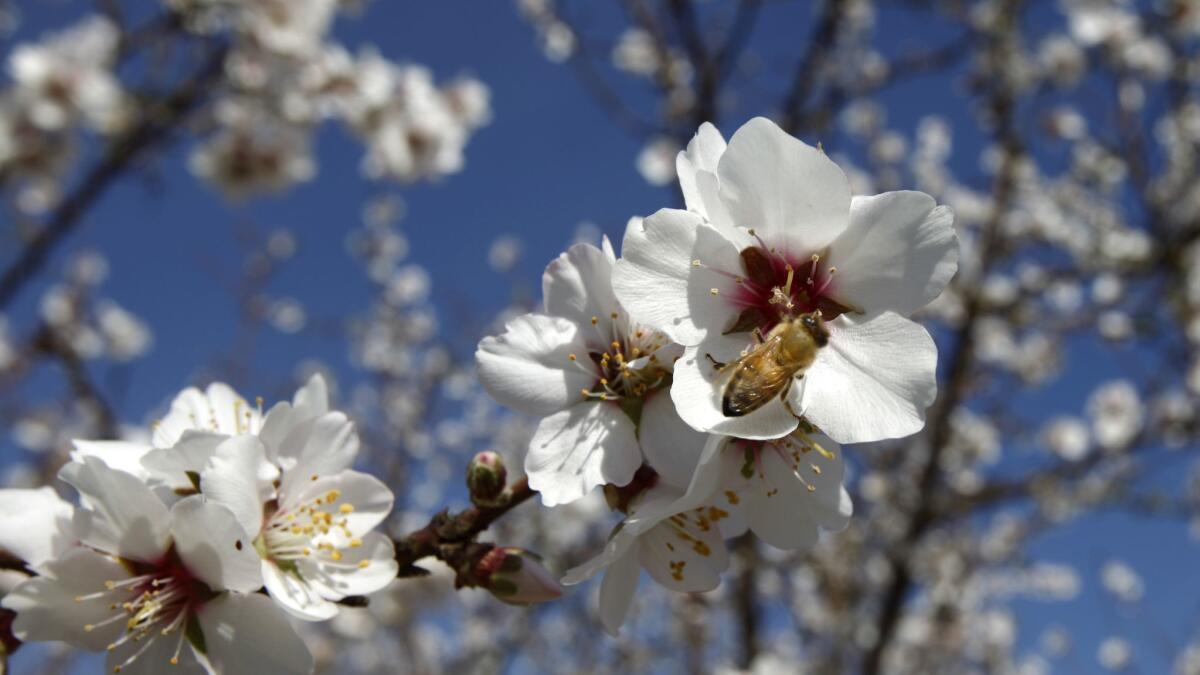Bees are at risk from common crop pesticides, California study finds

- Share via
California farmers could face more restrictions on how they combat crop-eating insects after a state report concluded that one class of pesticide poses a significant risk to bees that pollinate almonds and other crops.
The conclusion, published this week by the state Department of Pesticide Regulation, means growers of top crops such as nuts, wine grapes, citrus and berries will have to alter how they combat crop-destroying pests to strike a balance between losing crops and losing the bees that pollinate them.
“While it’s too soon to be specific, it is likely that we will be developing restrictions in the future that will require growers to modify when and where the pesticides are used,” said Charlotte Fadipe, spokeswoman for the California Department of Pesticide Regulation.
An outright ban on the pesticide class known as neonicotinoids, or neonics, is unlikely and unrealistic, Fadipe added. The agency already has a moratorium on any expansion of their use.
Large swaths of the state’s $45-billion agriculture industry depend on bee colonies brought in to pollinate crops. Almonds alone use about 1.8 million colonies, which can cost up to $190 apiece per season to rent, according to government and industry estimates.
Bee populations have been declining steadily for more than a decade, a trend blamed on the combined effects of pesticide exposure, predatory mites and the management practices of pollination service companies.
In the first three months of this year, nearly 78,000 colonies vanished from the nation’s commercial beekeeping stock — a phenomenon known as colony collapse, according to a newly released survey by the U.S. Department of Agriculture. That was a 15% increase in such collapses from the same period last year, according to the USDA.
Activists who have pushed for a ban on the pesticides said the report backs their case. “The more we learn about the toxicity of neonics, the more apparent it is that pretty much any plant with nectar or pollen sprayed with these poisons is unsafe for bees,” said Nathan Donley, a senior scientist with the Center for Biological Diversity.
The European Union banned some neonicotinoids on flowering plants in 2013, and earlier this year further restricted their use to greenhouses. Bayer Crop Science, which markets several pesticides based on neonicotinoids, has blasted the move as unfounded by science.
Bayer stood by its guidelines on how to apply the chemicals, which it said give growers an important tool to increase yields and feed a growing global population.
“What we can say unequivocally is that hundreds of studies have shown repeatedly that these important tools are safe and effective when used according to label,” the company said.
Renee Pinel, president and chief executive of the Western Plant Health Assn., an agro-chemical industry advocacy group, said the California report relied on “worst case scenarios and not real world or label application rates” commonly found on fields.
“California farmers are committed to following the law, and follow product labels stringently,” Pinel said.
State pesticide regulators said their “worst case” scenario was derived from what pesticide users and industry studies reported, and the agency used a risk calculation that was “realistic but protective.”
That analysis showed there was a significant risk to bees from chemical residue in pollen and nectar of tree nuts, citrus, berries, cotton and certain flowering vegetables such as cucumbers, squash and tomatoes.
California growers have more than doubled their use of neonicotinoids from 2007 to 2016, even as they decreased their reliance on organophosphate and carbamate pesticides that are considered more hazardous to human health, according to the report. About 195 tons of neonicotinoids were used on California fields in 2016, compared with 1,000 tons of organophosphates and carbamates, according to state pesticide regulators.
Scientists and some government regulators have progressively raised alarms about potential harm to bees from neonicotinoids, which are absorbed and distributed to all parts of a plant or tree, winding up in nectar and pollen in the blossoms where bees forage.
Managing bee exposure to those blooms during times when pesticides are applied can be complicated. Much of the state’s citrus industry, which uses neonicotinoids to combat the the Asian citrus psyllid, doesn’t depend on bees for pollination, but pollination service companies sometimes place their hives in locations that allow bees to also forage in citrus trees.
Some vegetables treated with the chemicals, such as leafy greens, are picked before they flower, and are considered “low risk” to bees.
Contaminated pollen and nectar also present different exposure scenarios. Because nectar is widely shared in hives, contamination can have a cascading effect. Tomato blossoms produce pollen but no nectar, while cotton, one of the most heavily sprayed crops, produces nectar that is highly attractive to bees.
State regulations are crafted to address different crop types, while citrus and almond growers have adopted bee protection plans or converted to self-pollinating varieties.
It will take about two years for the state to develop regulations based on the report. Even so, that is ahead of efforts by the federal Environmental Protection Agency, which has slowed its review of pesticides under President Trump.
Follow me: @LATgeoffmohan
UPDATES:
2:30 p.m.: This article was updated to include a statement from Bayer.
This article was originally published at 11:10 a.m.
More to Read
Inside the business of entertainment
The Wide Shot brings you news, analysis and insights on everything from streaming wars to production — and what it all means for the future.
You may occasionally receive promotional content from the Los Angeles Times.











